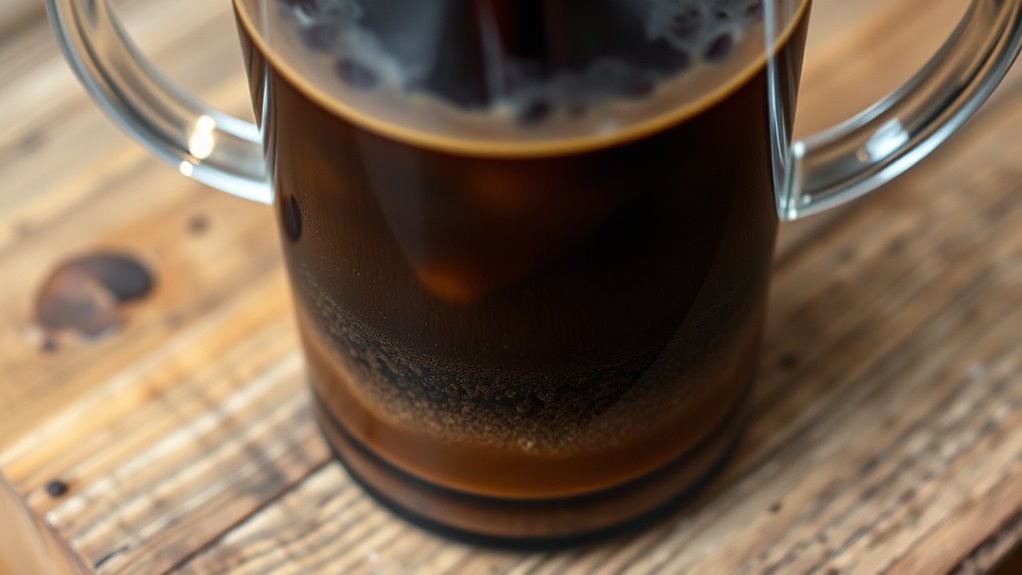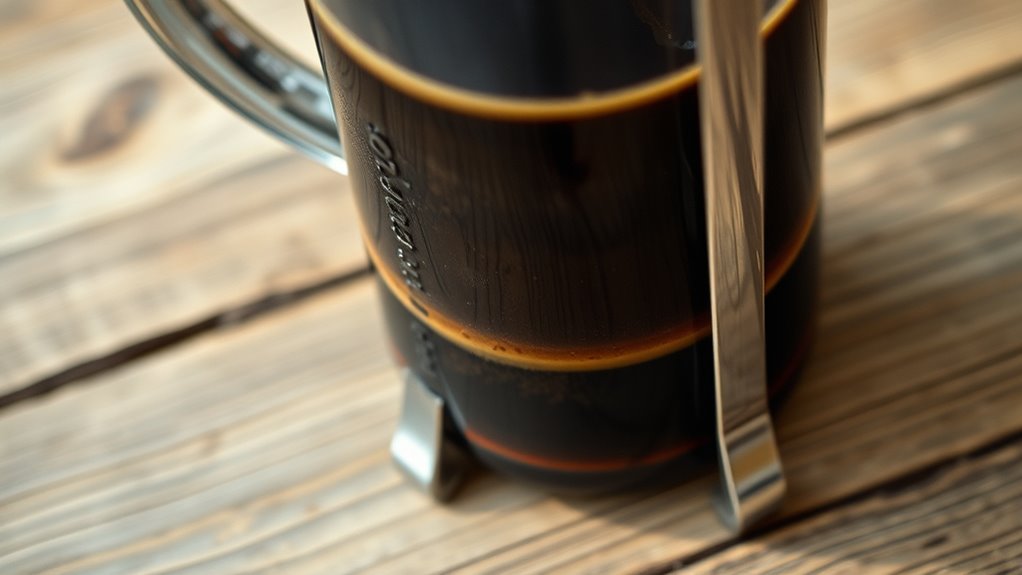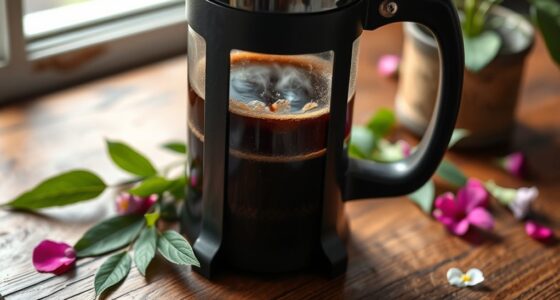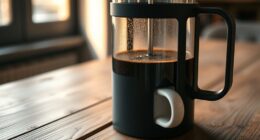To fix bitter, muddy, or flat French press coffee, start by adjusting your grind size—use a coarser grind to prevent over-extraction and muddiness, and a slightly finer grind for flat flavors. Also, check your brewing time; around four minutes is ideal, but shorten it if your coffee tastes bitter or extend if flat. Consider water temperature and use fresh grounds. Fine-tuning these factors can transform your brew—discover how to perfect your method step-by-step.
Key Takeaways
- Bitter coffee often results from overly fine grind or steeping over four minutes; coarser grind and shorter steeping can help.
- Muddy or sludgy brew indicates too fine a grind; switch to coarser grounds for clearer extraction.
- Flat or dull flavor suggests the grind is too coarse or steeping time is too short; fine-tune grind and extend steeping slightly.
- Use freshly ground coffee and maintain a consistent process for balanced extraction.
- Adjust brewing time and grind size gradually based on taste to troubleshoot and improve your French press coffee.

Ever wondered why your French press coffee sometimes doesn’t turn out as expected? One of the most common reasons is the grind size and brewing time not aligning with your brewing process. If your coffee ends up bitter, muddy, or flat, adjusting these elements can make a significant difference. When you use a grind that’s too fine, it creates more resistance during pressing, which increases extraction and often results in bitter coffee. Conversely, a grind that’s too coarse produces under-extraction, leaving your brew flat and weak. Finding the right grind size is essential. For French press, a coarse grind is generally recommended because it allows water to flow freely around the coffee grounds, ensuring an even extraction. If you notice your coffee tastes over-extracted and bitter, try a slightly coarser grind. If it’s flat or insipid, opt for a slightly finer setting, but avoid going too fine, as it can lead to muddy sludge at the bottom of your cup.
Brewing time also plays an important role in the flavor profile of your French press coffee. If you steep the grounds for too long, you risk over-extraction, which can bring out undesirable bitter flavors. Too short, and your coffee may taste weak or flat. Typically, a brewing time of about four minutes hits the sweet spot, but you can tweak it slightly depending on your taste preference. Be mindful that longer steeping times tend to extract more solubles from the coffee grounds, which can turn your brew bitter if you’re not careful. Conversely, shorter times might leave your coffee under-extracted, resulting in a thin, dull flavor. Timing is everything, so set a timer and stick to it.
Another factor to consider is your water temperature, but focusing on grind size and brewing time is a straightforward way to troubleshoot common issues. Always use freshly ground coffee and make sure your grind size matches your brewing method. Adjust your brew time based on taste; if your coffee tastes flat, try increasing the steeping duration slightly. If it’s bitter, reduce the brewing time or coarsen the grind. Experimenting with small adjustments can help you pinpoint the ideal combination. Remember, consistency is key. Once you find the perfect grind size and brewing time for your taste, stick to it, and your French press coffee will improve dramatically.
Frequently Asked Questions
Can the Type of Coffee Beans Affect French Press Taste?
Yes, the type of coffee beans affects your French press taste. Freshness is key—using freshly roasted beans ensures vibrant flavors, while stale beans can make your brew flat or bitter. The roast level also matters; lighter roasts highlight bright, acidic notes, whereas darker roasts offer richer, bolder flavors. Choosing quality beans and paying attention to freshness and roast level can considerably enhance your French press experience.
How Does Water Temperature Influence Brew Bitterness?
When it comes to brewing, hitting the right temperature is key—think of it as walking a tightrope. If your water’s too hot, it burns the coffee, leading to bitterness; too cool, and you get a flat brew. Water chemistry and brewing temperature influence extraction, so aim for around 200°F. This balance guarantees you avoid bitter over-extraction or weak flavors, giving your French press coffee a smooth, rich taste.
What’s the Best Way to Clean Stubborn Coffee Residue?
To clean stubborn coffee residue, start by disassembling your French press and rinsing all parts with hot water. Use a mixture of baking soda and vinegar or a dedicated coffee pot cleaner to scrub away stubborn stains. Regularly cleaning your press, especially if you keep a consistent brewing schedule, helps prevent buildup. Fresh, high-quality coffee beans also reduce residue, making cleanup easier and ensuring better-tasting brews.
Does Grind Size Impact the Muddy or Clear Appearance?
Yes, grind size considerably impacts brew clarity and can make your coffee appear muddy or clear. If your grind is uneven or too coarse, you’ll notice more sediment and a murky appearance. Using a consistent grind size helps guarantee proper extraction, resulting in a cleaner, brighter brew. Adjusting your grind to a medium-coarse setting can improve clarity and reduce muddiness, giving you a smoother, more transparent cup.
How Long Should I Steep Coffee for Optimal Flavor?
You should steep your coffee for about 4 minutes to achieve ideal flavor. Keep an eye on your brew time and avoid over-steeping, which can lead to bitterness. For a smoother cup, aim for a consistent steep duration of around 4 minutes, adjusting slightly based on your taste preferences. Remember, controlling your brew time helps prevent muddy or flat flavors, ensuring a rich, balanced coffee experience.
Conclusion
Remember, your French press is like a delicate garden; with patience and care, it blooms into rich, flavorful coffee. Troubleshooting unwanted bitterness, muddiness, or flatness is your way of tending to this garden, nurturing each step until perfection blossoms. When you master the process, every cup becomes a vibrant sunrise—bright, warm, and full of life. Keep your attention sharp, and watch as your brewing ritual transforms your mornings into a beautiful, aromatic landscape.








